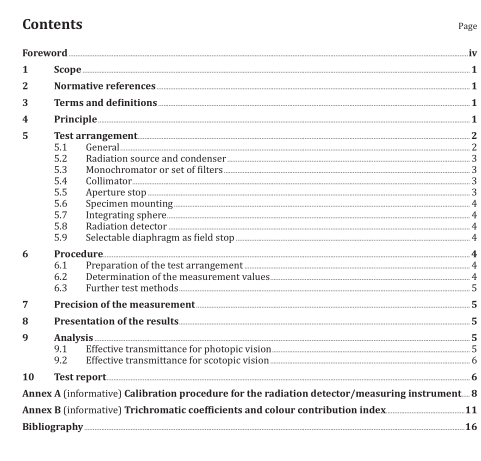ISO 14490-5:2021 pdf download.Optics and photonics — Test methods for telescopic systems — Part 5: Test methods for transmittance
5.2 Radiation source and condenser The radiation source shall emit a continuous flux of radiation in the specified wavelength range. The variation of flux during the measurement of a pair of values shall be less than 1 %. The condenser adapts the radiation source to the optical measurement path.
It should be, for example, an achromatic doublet or an off-axis paraboloidal mirror to avoid introducing too much lateral chromatism into the optical ray path.
5.3 Monochromator or set of filters
The monochromator or the set of filters can be omitted if the signal processing unit comprises a spectral detector. Grating or prism monochromators can be used to select the wavelength.
The smallest adjustable wavelength interval shall be less than 2 % of the dominant wavelength (usually 0,55 µm) of the respective measurement. The necessary spectral bandwidth depends on the sample. It should be ensured that a steep change in the transmission curve is detected correctly.
Thus, the bandwidth should be selected such that the transmittance across the band changes by less than 4 %. This condition cannot always be satisfied because of technical measurement and energetical reasons or because the time/cost effort is not adequate. In these cases, a maximum bandwidth of 4 % of the wavelength is allowable. A bandwidth of less than 2 % of the wavelength is necessary if the colour contribution indices are to be calculated. Instead of a monochromator, a set of narrow-band filters (full width half maximum <20 nm) may be used. They are especially useful with flat-shaped transmission curves. The number of measuring points shall allow for a definite curve fitting. A measurement with spectral filters instead of a monochromator is also appropriate if only single measurements are required.
5.4 Collimator
The collimator may contain a refracting lens or a mirror. The collimator shall be adjusted to the aligned components in such a way that full and uniform illumination of the following aperture stop is assured. The focal length of the collimator shall be long enough that in relation to the field stop of the collimator the spot diameter is small enough to pass the image plane of the test specimen and is not obscured by target marks and internal structures. One-third of the image plane diameter should not be exceeded.
The ray bundle shall be collimated as well as possible within the measurement distance by adjusting the collimator position. The axial chromatic aberration of a refracting lens shall be less than or equal to 1 % of its focal length in the spectral range used. An off-axis parabolic mirror or an equivalent system is also suitable as a collimator. 5.5 Aperture stop The aperture stop should be circular and located close to the objective lens of the test specimen if possible. The diameter should be ≤ 50 % of the entrance pupil of the test specimen, as well as smaller than the opening of the integrating sphere. Auxiliary systems can be used for beam forming to realize these requirements. These systems shall stay in the ray path during the measurement with and without test specimen.
Generally, the smallest possible aperture stop should be used which is compatible with the signal-to- noise requirements of the detector. Special care should be taken when measuring telescopic systems with variable magnification where at some magnification settings the entrance pupil can be considerably smaller than the free objective lens diameter.
5.6 Specimen mounting
The mounting of the test specimen shall be designed in a way that the test specimen can be positioned and aligned and held stable. The test specimen should be oriented such that no obstructions occur in the measurement beam (e.g. by reticle structures).
5.7 Integrating sphere The distance between the aperture stop and the integration sphere shall be arranged according to the requirements of the test specimen. The distance shall not be changed during the measurement with and without test specimen such that the light is always completely collected by the integrating sphere.
To avoid the impact of multiple reflections, a large distance, e.g. 100 mm, between the eyepiece and the integrating sphere is recommended. The position of the integrating sphere should be chosen so that the diameter of the ray bundle entering the integrating sphere is almost the same as without the specimen. The integrating sphere has two openings, one for the input of the bundle of rays to be measured and one for the detector. The openings shall not be located opposite each other. Direct radiation incident on the detector is prevented by baffles.
The surfaces of the two openings together shall not occupy more than 5 % of the internal surface of the sphere. The diameter of the integrating sphere opening shall exceed the maximum diameter of the aperture stop (item 6 in Figure 1 and Figure 2) by at least 5 % to 7 %. The reflectance of the internal coating of the integrating sphere shall be as high as possible and diffuse across the whole spectral range. The reflectance across the whole spectral range from 380 nm to 780 nm shall be at least 85 %.ISO 14490-5 pdf download.ISO 14490-5 pdf download
